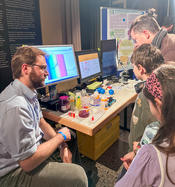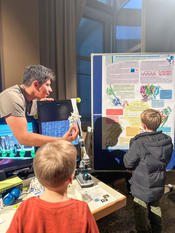Berlin Science Week 2024
SFB 1078 at the Berlin Science Week
The Berlin Science Week took place from 1.-10. November with up to 200 events in-person and online - see the full program. Young scientists from the SFB presented their research on protonation dynamics in protein function:
-
1./2.11. @ Berlin Science Week Campus
Visitors were able to stop by our booth at the Natural History Museum to talk to the research team in person. Using five model proteins as examples, young scientists in the SFB's Research Training Group want to understand how proton movement controls the way proteins work: in the photosystem of plants for energy production, in cytochrome c oxidase in the power plant of our cells, in channel rhodopsin for light manipulation of nerve impulses, in phytochrome, which makes plants flower, and in viroporin, which allows viruses to replicate in the human body.
SFB members collaborated with "young" scientists to conduct experiments using red cabbage as a natural pH indicator. These experiments explored how proton release and uptake influence the properties of a solution. The pigments in red cabbage respond to changes in proton concentration by altering their molecular structure, leading to striking color changes.
In the first step, red cabbage juice was placed in a cuvette, displaying its characteristic red color. Next, various household materials were added to the solution. Depending on their acidic or basic properties, these materials caused the cabbage juice to change color. For example, adding lemon juice, which releases protons, shifted the solution to a lighter red hue. This color change occurred because the pigments in red cabbage absorbed additional protons, altering their molecular structure and light absorption properties.
In contrast, when soap, a basic substance that removes protons, was added, the juice turned blue. This experiment elegantly demonstrated how protonation and deprotonation dynamics induce structural changes in molecules. It also served as a model for how proteins respond to changes in their protonation state, ultimately affecting their function and behavior.
The young scientists used an absorption spectrometer to quantitatively analyze the color changes across the visible spectrum. The spectrometer revealed distinct absorption patterns corresponding to the observed colors. This allowed the young scientists to deepen their understanding of the relationship between pH, molecular changes, and light absorption, effectively linking their visual observations to precise scientific measurements.
Since 2019 the SFB 1078 participates annually in the Berlin Science Week: a 10 days international interdisciplinary event that brings together scientific organizations to promote public awareness of science.







